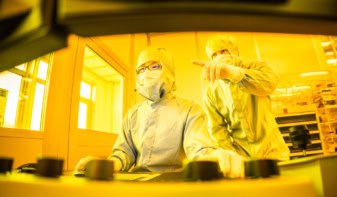
Light waves confined in an evaporating water droplet provide a useful model of the quantum behaviour of atoms, researchers in Sweden and Mexico have discovered. Through a simple experiment, a team led by Javier Marmolejo at the University of Gothenburg has shown how the resonance of light inside droplets of specific sizes can provide robust analogies to atomic energy levels and quantum tunnelling.
When light is scattered by a liquid droplet many times larger than its wavelength, some of the light may reflect around the droplet’s internal edge. If the droplet’s circumference is a perfect multiple of the light’s wavelength inside the liquid, the resulting resonance will cause the droplet to flash brightly. This is an optical example of a whispering gallery mode, whereby sound can reflect around a circular room.
This effect was first described mathematically by the German physicist Gustav Mie in 1908 – yet despite the simplicity of the scenario, the rich array of overlapping resonances it produces can create some incredibly complex patterns, some of which have yet to be studied in detail.
Optical tweezers
To explore the effect in more detail, Marmolejo and team devised an experiment where they confined water droplets using optical tweezers, then they evaporated the liquid by heating it with a fixed-frequency laser. As the droplets shrank, their circumferences were sometimes equal a multiple of the laser’s wavelength. At these “Mie resonances”, the droplets flashed brightly.
As they studied this effect, the researchers realized that the flashing droplets are analogous to the quantum behaviours of atoms. In these “optical atoms”, orbiting electrons are replaced with resonating photons. The electrostatic potential that binds electrons to the nucleus is replaced by the droplet’s refractive index, which tends to trap light in the droplet by internal reflection. The quantized energy levels of an atom are represented by the droplet sizes where Mie resonances occur.
Marmolejo’s team also spotted an analogy to quantum tunnelling in the optical response of the droplets. As light waves first encounter the confining potential of a droplet, some of the light is reflected. The rest of the light tunnels through the confining potential, resonates, and then leaks out. This created interference patterns which strongly resemble Fano resonances, which were first spotted when electrons were scattered from atoms.
Atomic analogue
Despite being over 100,000 times larger than real atoms, the researchers propose that their optical atom could provide a useful model for studying the inner workings of atoms. They also suggest that the droplets could boost our understanding of the scattering of light.
Beyond its interesting potential for research, the team also hopes the experiment could have useful practical applications in areas including medicine and environmental monitoring. Here, chemicals contained in confined, evaporating droplets would modify the refractive index of the liquid, which would change the sizes at which they flash. This could be used to monitor for pollutants.
The research is described in Physical Review Letters.



